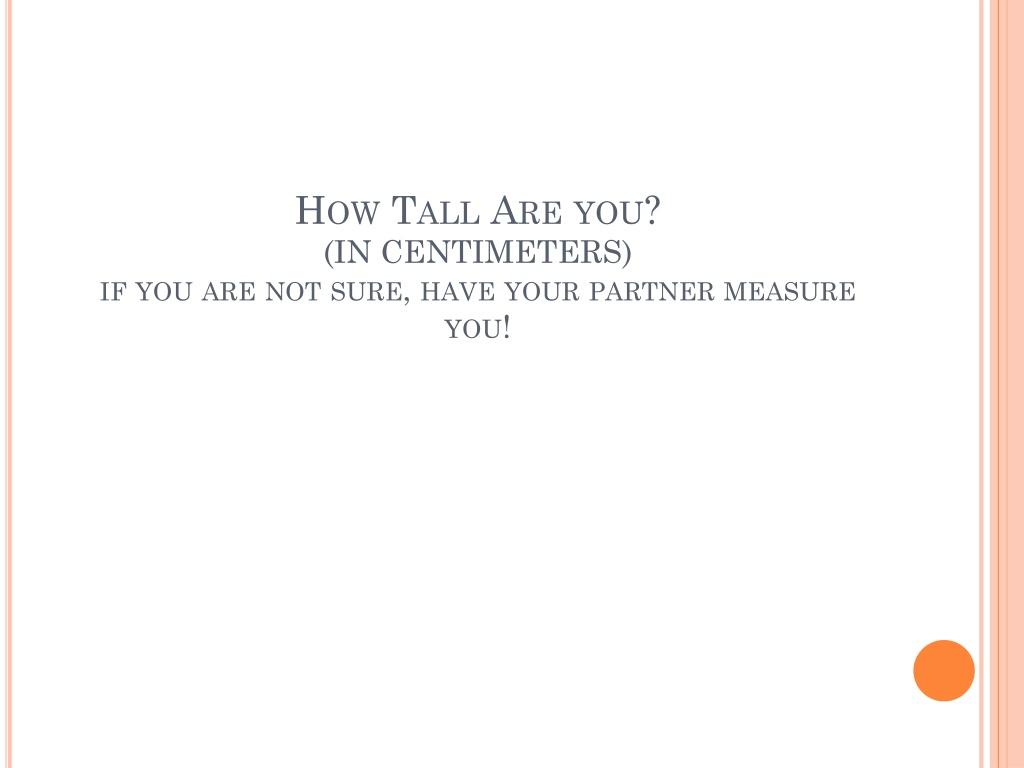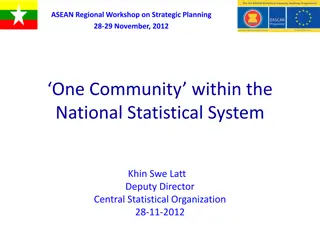Statistical Concepts Through Visualizations
Explore various statistical concepts such as percentiles, Ogive, z-score, and distribution using real-world examples like Major League Baseball wins, senator ages in the 103rd Congress, and state income distributions. Learn how to interpret data, make analyses, and derive insights through visual representations like stem plots, cumulative frequency graphs, and more.
Download Presentation

Please find below an Image/Link to download the presentation.
The content on the website is provided AS IS for your information and personal use only. It may not be sold, licensed, or shared on other websites without obtaining consent from the author. Download presentation by click this link. If you encounter any issues during the download, it is possible that the publisher has removed the file from their server.
E N D
Presentation Transcript
HOW TALL ARE YOU? (IN CENTIMETERS) IF YOU ARE NOT SURE, HAVE YOUR PARTNER MEASURE YOU!
2.1A DESCRIBING LOCATION IN A DISTRIBUTION Using percentiles Making an Ogive Calculating and Interpreting a z-score
What is a percentile?
Wins in Major League Baseball The stemplot below shows the number of wins for each of the 30 Major League Baseball teams in 2009. Key: 5|9 represents a team with 59 wins. 5 9 6 2455 7 00455589 8 0345667778 9 123557 10 3
5 9 6 2455 7 00455589 8 0345667778 9 123557 10 3 Key: 5|9 represents a team with 59 wins. Calculate and interpret the percentiles for the Colorado Rockies (92 wins), the New York Yankees (103 wins) and the Cleveland Indians (65 wins).
Age of Senators in the 103rd Congress (n=100) Freq Rel Freq Cumul. Rel. Freq 30 < 40 40 < 50 50 < 60 60 < 70 70 < 80 80 < 90 1 0.01 0.16 0.49 0.22 0.11 0.01 16 49 22 11 1
Age of Senators in the 103rd Congress (n=100) Freq Rel Freq Cumul. Rel. Freq 0.01 0.17 0.66 0.88 0.99 1.00 30 < 40 40 < 50 50 < 60 60 < 70 70 < 80 80 < 90 1 0.01 0.16 0.49 0.22 0.11 0.01 16 49 22 11 1
Age of Representatives in the 103rd Congress (n=435) Freq Rel Freq Cumul. Rel. Freq 30 < 40 40 < 50 50 < 60 60 < 70 70 < 80 80 < 90 47 153 131 89 12 3
State Median Household Incomes Below is a cumulative relative frequency graph showing the distribution of median household incomes for the 50 states and the District of Columbia.
State Median Household Incomes Below is a cumulative relative frequency graph showing the distribution of median household incomes for the 50 states and the District of Columbia.
a) California, with a median household income of $57,445, is at what percentile? Interpret this value.
b) What is the 25th percentile for this distribution? What is another name for this value?
c) Where is the graph the steepest? What does this indicate about the distribution?
Bellwork: 9/11/19 1) Find the median for France 2) Find the IQR for the Philippines
Macy, a 3-year-old female is 100 cm tall. Brody, her 12-year-old brother is 158 cm tall. Obviously, Brody is taller than Macy but who is taller, relatively speaking? That is, relative to other kids of the same ages, who is taller? (According to the CDCP, the heights of three-year-old females have a mean of 94.5 cm and a standard deviation of 4 cm. The mean height for 12-year-olds males is 149 cm with a standard deviation of 8 cm.)
Year 1927 1961 1998 2001 Player Babe Ruth Roger Maris Mark McGwire Barry Bonds HR 60 61 70 73 Mean 7.2 18.8 20.7 21.4 SD 9.7 13.4 12.7 13.2 To make a fair comparison, we should see how these performances rate relative to others hitters during the same year. Calculate the standardized score for each player and compare.
Year 1927 1961 1998 2001 Player Babe Ruth Roger Maris Mark McGwire Barry Bonds HR 60 61 70 73 Mean 7.2 18.8 20.7 21.4 SD 9.7 13.4 12.7 13.2 In 2001, Arizona Diamondback Mark Grace s home run total had a standardized score of z = 0.48. Interpret this value and calculate the number of home runs he hit.
2.1B DESCRIBING LOCATIONINA DISTRIBUTION TRANSFORM data DEFINE and DESCRIBE density curves
Dot Plot Kobe 2009 0 10 20 30 40 50 60 70 PTS Here is a dotplot of Kobe Bryant s point totals for each of the 82 games in the 2008-2009 regular season. The mean of this distribution is 26.8 with a standard deviation of 8.6 points. In what percentage of games did he score within one standard deviation of his mean? Within two standard deviations?
Dot Plot individual_player_gamebygamelog 0 2 4 6 8 10 12 14 16 SO Here is a dotplot of Tim Lincecum s strikeout totals for each of the 32 games he pitched in during the 2009 regular season. The mean of this distribution is 8.2 with a standard deviation of 2.8. In what percentage of games were his strikeouts within one standard deviation of his mean? Within two standard deviations?
Effect of Adding (or Subtracting) a Constant Adding the same number a (either positive, zero, or negative) to each observation: adds a to measures of center and location (mean, median, quartiles, percentiles), but Does not change the shape of the distribution or measures of spread (range, IQR, standard deviation).
Effect of Multiplying (or Dividing) by a Constant Multiplying (or dividing) each observation by the same number b (positive, negative, or zero): multiplies (divides) measures of center and location by b multiplies (divides) measures of spread by |b | , but does not change the shape of the distribution
In 2010, Taxi Cabs in New York City charged an initial fee of $2.50 plus $2 per mile. In equation form: fare = 2.50 + 2(miles). At the end of a month a businessman collects all of his taxi cab receipts and analyzed the distribution of fares. The distribution was skewed to the right with a mean of $15.45 and a standard deviation of $10.20.
a) What are the mean and standard deviation of the lengths of his cab rides in miles?
Density Curves In Chapter 1, we developed a kit of graphical and numerical tools for describing distributions. Now, we ll add one more step to the strategy.
Exploring Quantitative Data 1. Always plot your data: make a graph. 2. Look for the overall pattern (shape, center, and spread) and for striking departures such as outliers. 3. Calculate a numerical summary to briefly describe center and spread. 4. Sometimes the overall pattern of a large number of observations is so regular that we can describe it by a smooth curve.
Definition: A density curve is a curve that is always on or above the horizontal axis, and has area exactly 1 underneath it. A density curve describes the overall pattern of a distribution. The area under the curve and above any interval of values on the horizontal axis is the proportion of all observations that fall in that interval.
In this section, we learned that There are two ways of describing an individual s location within a distribution the percentile and z-score. A cumulative relative frequency graph allows us to examine location within a distribution. It is common to transform data, especially when changing units of measurement. Transforming data can affect the shape, center, and spread of a distribution. We can sometimes describe the overall pattern of a distribution by a density curve (an idealized description of a distribution that smooths out the irregularities in the actual data).






























